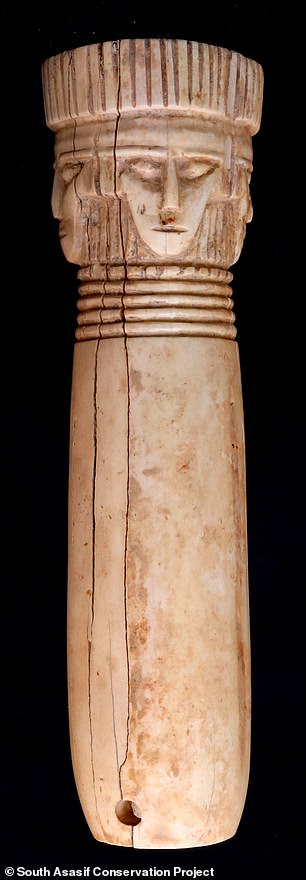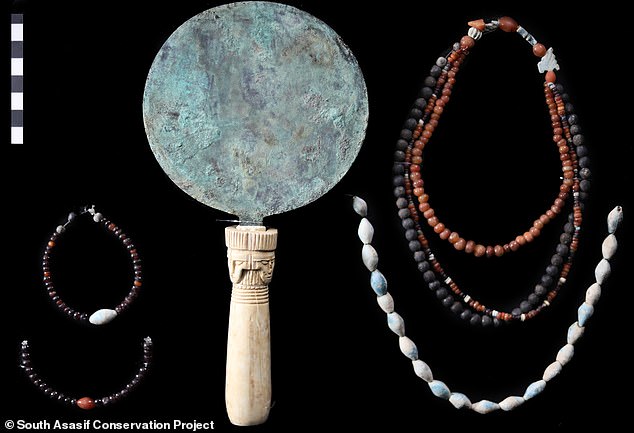Archaeologists make first-of-its-kind discovery in ancient Egyptian tomb
Archaeologists have unearthed a unique ancient Egyptian tomb that is almost 4,000 years old.
The burial chamber contained the remains of eleven men, women and children, indicating that it was a family cemetery used for generations during the 12th and 13th Dynasties.
The find marks the first Middle Kingdom tomb discovered in the area, which ranged from 1938 BC to 1630 BC.
American and Egyptian researchers from the South Asasif Conservation Project noted that the bodies lay side by side in wooden coffins, with their heads facing in alternate directions.
Although centuries-old floods had destroyed the wooden coffins and their linen wrappings, researchers found that items such as figurines and jewelry – including a necklace and a hippopotamus head amulet – were still intact.
Among the treasures were two copper mirrors, one with a lotus-shaped handle and the other with a design of Hathor – the Egyptian goddess of the sky, women, fertility and love.
The tomb was discovered next to the Temple of Hatshepsut on the west bank of the Nile in Luxor.
Katherine Blakeney, the foremost American archaeologist, said: ‘The excavation of the first tomb of the Middle Kingdom in the necropolis of South Asasif changes its history, placing South Asasif within the vast necropolis of the Theban Middle Kingdom.’

Researchers plan to continue excavations to find other artifacts that could shed light on how people lived during the Middle Kingdom in Egypt

The artifacts include a bead necklace made of amethyst that was discovered while the archaeologists were carrying out restoration work on the tomb of Karabaskin, a 25th Dynasty official.
The researchers identified skeletons of five women, two men and three children, with the gender and age of the last family member still unknown.
The discovery was made during restoration work on the tomb of Karabaskin, a 25th dynasty mayor of Thebes and the fourth priest of Amun, according to Egypt’s Ministry of Tourism and Antiquities (MTA).
Archaeologists said the find changed the history of South Asasif, which was previously thought to contain only burials from the 18th, 22nd, 25th and 26th dynasties of ancient Egypt, ranging from 1550 BC to 525 BC.
The graves likely date from the region’s 12 most important families, the MTA said, adding that the find could add to archaeologists’ understanding of the burial practices and rituals of the time.
Most of the jewelry was found among the woman’s remains, with the exception of a beautiful necklace discovered in one of the men’s graves.
This was perhaps the most striking of the discoveries, because the necklace, which consisted of thirty amethyst beads and two agate beads around the head of a hippopotamus, indicated that the man held a high position.
During the Theban Middle Kingdom, the hippopotamus was considered of paramount importance because it represented the power of the Nile and was often buried in tombs to protect the deceased as they entered the afterlife.
Statues of hippos were commonly found in Middle Kingdom tombs and were sometimes depicted as the pregnant goddess Taweret, meaning fertility and protection.

This necklace was considered the most important because it was the only one that belonged to a man and possibly signified that he was of a higher rank

Archaeologists found necklaces, bracelets and other artifacts belonging mainly to women in the tomb
The animal also decorated red agate necklaces, bracelets, rings and belts that were still in good condition when the grave was opened.
“Such craftsmanship underlines the cultural and artistic sophistication of the Middle Kingdom,” Blakeney said Archaeological magazine.
Egyptians living during the Middle Kingdom experienced a period of prosperity and political stability.
After decades of disorder, they built a strong centralized government and had thriving trade and successful agriculture that led to abundant food production and a booming economy.
Pharaohs in the 12th Dynasty were considered “good shepherds” who actively cared for their people, and members of the middle class saw their lives improve as they gained access to more consumer goods.
It is believed that the Middle Kingdom reached its peak during this time when the pharaohs Amenemhet I and Senusret I boosted the people’s prosperity, cultural, artistic and literary achievements.
The US team said it now plans to carry out additional excavations in the area to reveal more aspects of the ancient tomb and shed light on how its inhabitants lived during the Middle Kingdom era.
